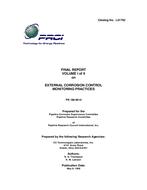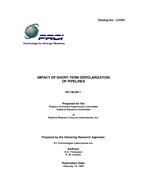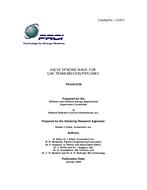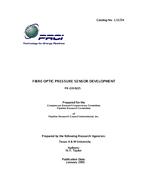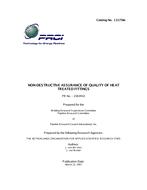Provide PDF Format
PRCI PR-186-9610
- External Corrosion Control Monitoring Practices (Vol. I & II)
- Report / Survey by Pipeline Research Council International, 05/08/2000
- Publisher: PRCI
$148.00$295.00
L51792e
CC Technologies Labs, Inc.
Need: The primary means of corrosion control for buried pipelines is the use of an external pipeline coating and the application of cathodic protection (CP). Monitoring the effectiveness of the corro sion control system is critical to the safe operation of natural gas pipelines. NACE International has established criteria and
recommended practices for monitoring the effectiveness of CP systems (RPO169-96). These practices and criteria have generally been accepted by regulatory agencies. Over the years a significant amount of research has been performed that is related to monitoring practices. Much of this research has been directed at improving measurement techniques that are aimed at satisfying the NACE criteria. In general, no significant effort has been made to incorporate research into currently used monitoring practices.
Benefit: The overall objectives of this project were (1) to consolidate research previously performed on monitoring the effectiveness of cathodic protection of pipelines, (2) to analyze the different monitoring techniques in light of the research, and (3) to produce monitoring guidelines that describe the application of these monitoring techniques for typical natural gas pipelines. The scope of this project was limited to the review of previous work, both PRCI funded and the open literature, and discussions with industry personnel. No field work or laboratory experiments were conducted. This project was further limited to the review of methodologies related to monitoring the effectiveness of the CP system and does not include methods for evaluating coatings. The research project was divided into the following two tasks: Task 1 - Review of Research and Practices and Task 2 - Development of Guidelines. This work was a consolidation of research that has been performed by the PRCI and others over the past several years. This review took the individual monitoring techniques (on-potential, off-potential, depolarized potential, close interval survey, etc.) and applied them to the typical pipeline scenarios (poorly-coated line, well-coated line, foreign line crossing, area with dynamic stray current, etc.). Each individual monitoring technique is summarized in terms of purpose, description, application, limitations, special considerations, and equipment requirements. Each pipeline scenario is supported with composite and line maps and the guidelines for each scenario are described in terms of a general description, applicable techniques, special considerations, measurement procedures, measurement locations, measurement frequency, applicable criteria, and data interpretation.
Result: The following are general conclusions based on this review. Significant research has been performed on several techniques used for monitoring the effectiveness of cathodic protection. This research was reviewed and discussion of the techniques is presented on an individual monitoring technique basis in Appendix A. Several pipeline scenarios were identified. Although research directed at specific scenarios is limited, several research projects were shown to have impact on the monitoring practices as applied to individual scenarios.
CC Technologies Labs, Inc.
Need: The primary means of corrosion control for buried pipelines is the use of an external pipeline coating and the application of cathodic protection (CP). Monitoring the effectiveness of the corro sion control system is critical to the safe operation of natural gas pipelines. NACE International has established criteria and
recommended practices for monitoring the effectiveness of CP systems (RPO169-96). These practices and criteria have generally been accepted by regulatory agencies. Over the years a significant amount of research has been performed that is related to monitoring practices. Much of this research has been directed at improving measurement techniques that are aimed at satisfying the NACE criteria. In general, no significant effort has been made to incorporate research into currently used monitoring practices.
Benefit: The overall objectives of this project were (1) to consolidate research previously performed on monitoring the effectiveness of cathodic protection of pipelines, (2) to analyze the different monitoring techniques in light of the research, and (3) to produce monitoring guidelines that describe the application of these monitoring techniques for typical natural gas pipelines. The scope of this project was limited to the review of previous work, both PRCI funded and the open literature, and discussions with industry personnel. No field work or laboratory experiments were conducted. This project was further limited to the review of methodologies related to monitoring the effectiveness of the CP system and does not include methods for evaluating coatings. The research project was divided into the following two tasks: Task 1 - Review of Research and Practices and Task 2 - Development of Guidelines. This work was a consolidation of research that has been performed by the PRCI and others over the past several years. This review took the individual monitoring techniques (on-potential, off-potential, depolarized potential, close interval survey, etc.) and applied them to the typical pipeline scenarios (poorly-coated line, well-coated line, foreign line crossing, area with dynamic stray current, etc.). Each individual monitoring technique is summarized in terms of purpose, description, application, limitations, special considerations, and equipment requirements. Each pipeline scenario is supported with composite and line maps and the guidelines for each scenario are described in terms of a general description, applicable techniques, special considerations, measurement procedures, measurement locations, measurement frequency, applicable criteria, and data interpretation.
Result: The following are general conclusions based on this review. Significant research has been performed on several techniques used for monitoring the effectiveness of cathodic protection. This research was reviewed and discussion of the techniques is presented on an individual monitoring technique basis in Appendix A. Several pipeline scenarios were identified. Although research directed at specific scenarios is limited, several research projects were shown to have impact on the monitoring practices as applied to individual scenarios.

